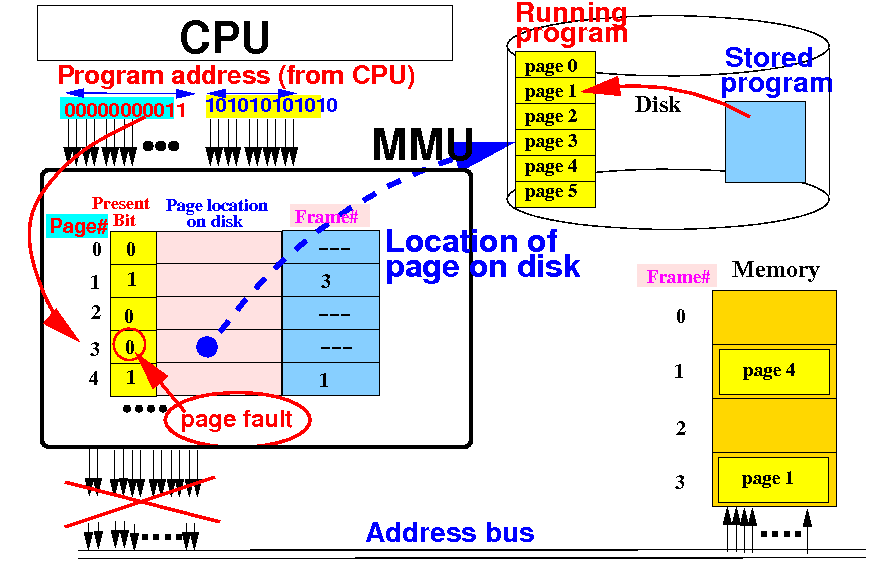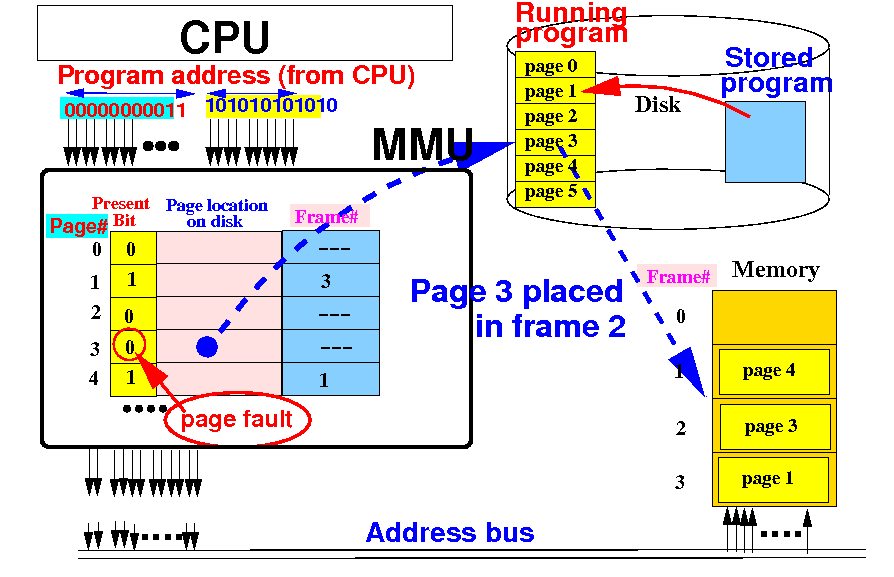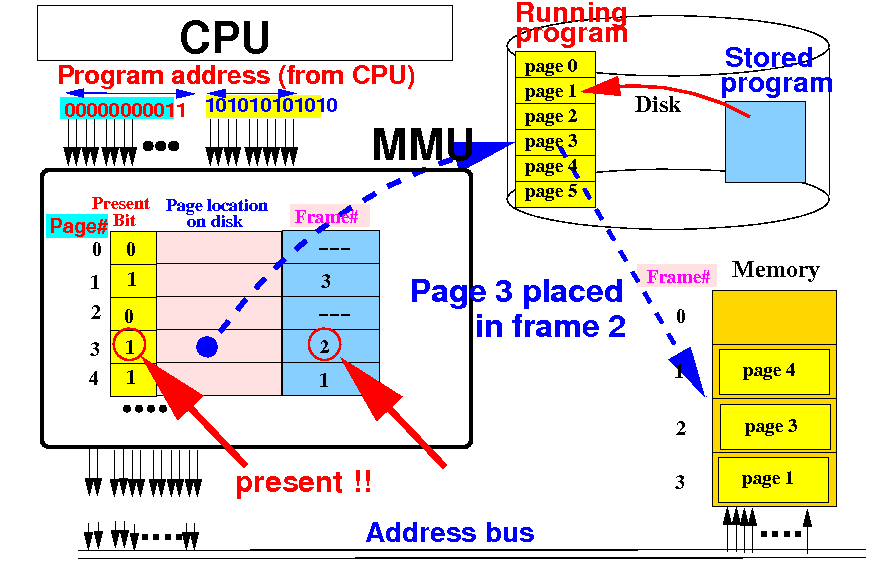Computer System with
paging
- A computer system that
implements
paging will:
- Assign
each
running program is
a
number of
memory frames that
it can use to store
its program pages
|
-
Important fact:
- The
number of
memory frames
assigned to
a running program can be
much smaller than the
number of
pages
in the program
|
- The computer system with
paging
will
make sure that:
- All pages that are
needed to
execute the
current instruction
of the
program are
present in
memory
|
This will require that:
- Some pages stored
in the memory be
swapped out
and
replaced
with new pages in the
program !!
|
|
How a
program will run in a computer system
with
paging
- Fact:
- Programs usually
consists
of many loops
- A program
runs for
a long time in a
loop.
|
- How a
program
run in a
computer system with
paging:
- While the
program is
executing instructions in the
current loop:
- When the
program
exits the
current loop
and possibly
enters a
new loop:
- The pages in the
memory (frames) will
replaced with
the pages of the
new loop
|
|
|
Computer System with
paging
- Graphical depiction of
a computer system with
paging:

- A running program is
stored
in its
entirety in
disk
- A few
memory frames is
allocated (= reserved) for the
running program.
|
Computer System with
paging
- At one point in
time,
some subset of
program pages will be
present in
memory frames:
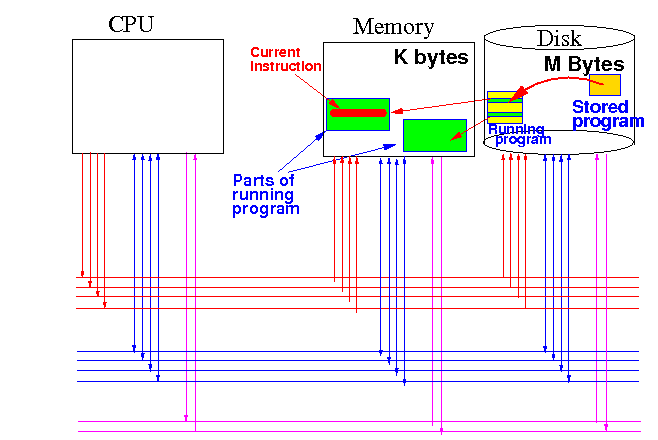
- The memory will
contain
all the
program pages
necessary to
execute the
current loop
|
Computer System with
paging
- At a later
point in
time,
another subset of
program pages will be
present in
memory:

- The memory will
contain
all the
program pages
necessary to
execute the
new loop
- The paging system will
detect
page faults and
fetch the
missing pages from
disk
|
Detecting a
page hit
- Page hit:
- A page hit is
detected by
Present Bit = 1 for
the page number
requested
|
Example:

|
Detecting a
page fault
- Page fault:
- A page fault
is
detected by
Present Bit = 0 for
the page number
|
Example:
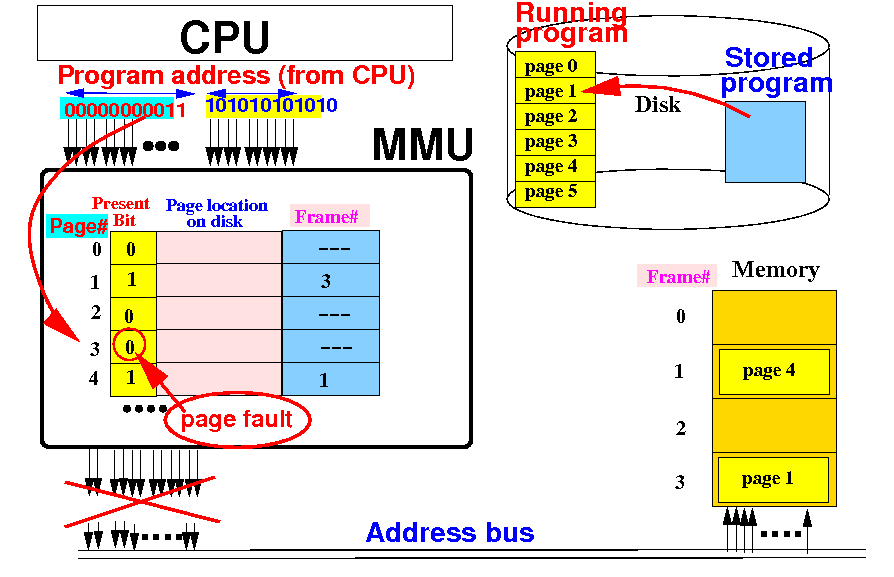
|
What to do
when there is a
page fault
-
Consequence
of a Page fault:
- The execution of the
(running) program
cannot continue
|
- What must be
done to
allow the
(running) program to
continue execution:
- The paging system
defines a
page fault
handling mechanism to:
-
fetch
the page
that is needed
(from disk)
to complete the
execution of the
current instruction
|
- The
page fault
handling mechanism
consists of:
-
A procedure
(= function)
to
fetch
the missing page
from disk
and
place it in
some frame
-
Update the
page table to
adjust the
dynamic
address mapping function !!
|
|
Where is the
missing program page
found on the disk ??
Where is the
missing program page
found on the disk ??
Background info on
page fault handling
- Page fault
handling
requires:
- Fetching a
program page from
disk
(= an
IO device !!!)
|
- IO devices are
slooooooooow....
- Note that a
page fault is
similar to:
-
Performing an
IO operation
on the
disk !!!
|
-
Effect of
a
page fault is
the
same as
performing an
IO operation:
- The
running program
cannot continue
because it must
wait for the
(very slow)
IO transfer operation
|
- We also have
learned
how
to
handle the
IO operation
efficiently before:
- Use the
DMA to
perform the
IO operation
- Use
context switching to
make the current process
(with page fault)
wait
|
|
Background info on
page fault handling
Computer system with
page fault handling
- A computer system
with
page fault handling
looks as follows:
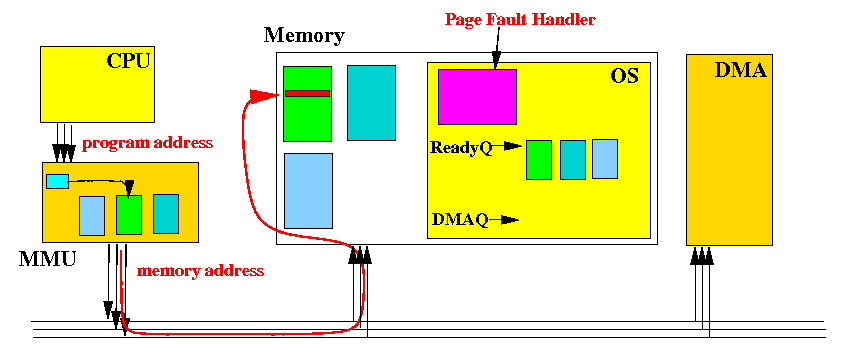
- The MMU uses the
entries in the
current page table
to perform
address mapping
- The
OS (Operating System)
contains a
page fault (interrupt) handler
which gets
invoked
when a page fault is
detected
|
|
Handling a
page fault
- Suppose the
execution of the
current instruction results
in a
page fault:
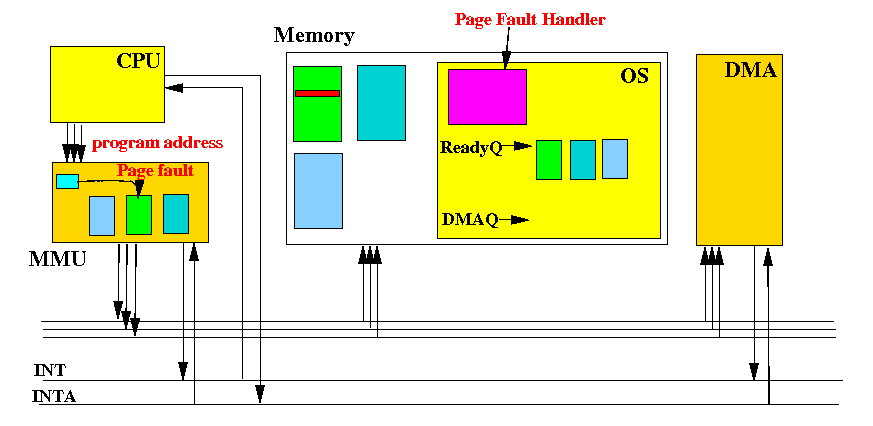
- The page fault is
detected by the
present bit = 0 in
the page table entry
|
Handling a
page fault
- When the
MMU detect a
page fault,
it will
emits
an
interrupt (INT)
signal:

- The CPU will
detect by the
INT signal
and initialize the
vector interrupt handling
protocol
(see:
click here)
to
identify the
interrupt handler
|
Handling a
page fault
- The
vector interrupt handling
mechanism will
cause the
CPU to
perform a
"unplanned" subroutine call
to the
page fault (interrupt) handler:

- The
page fault (interrupt) handler
subroutine will be
discussed next...
|
Pseudo code of the
Page Fault (interrupt) handler
Summary: handling a
page fault
- Situation
before
the execution of the
page fault handler:
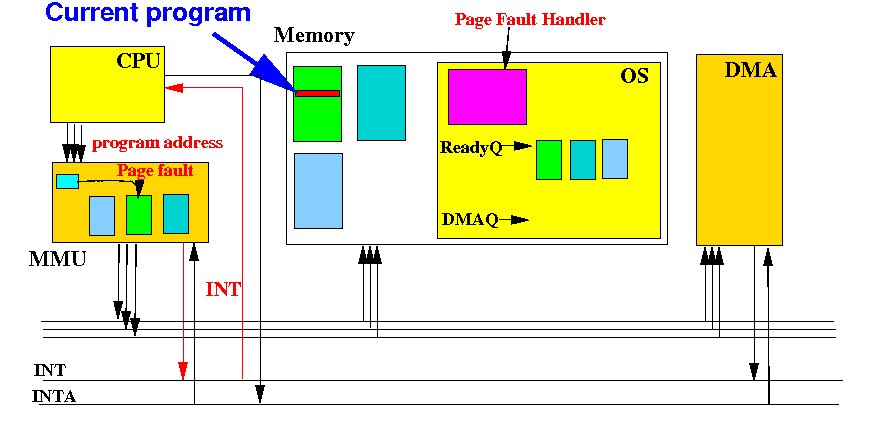
- The
current program
has a
page fault
and
cannot continue
|
Summary: handling a
page fault
- Situation
after
the execution of the
page fault handler:
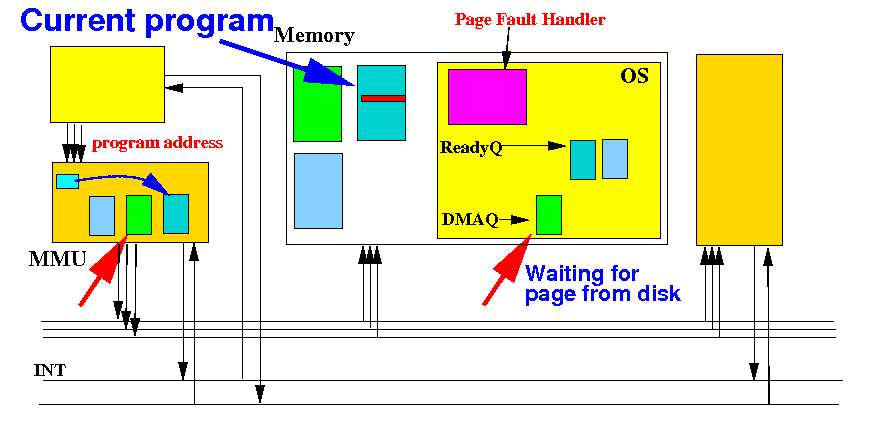
- A
"new"
current program
is running
(i.e.: CPU is
not
wasted)
The
DMA is
fetching
the page
from disk for
the program that had a
page fault
|
The program that
had a
page fault will
resume execution when the
DMA is
finished
(how ???:
interrupt !!)
The Interrupt Handling Routine for the
DMA device
without support for
paging fault handling
- The
DMA interrupt handler
needs to
be
modified with
page fault support
- The
DMA interrupt handler
that was discussed
previously is as follows:
(
click here)
The Interrupt Service Routine for the DMA device:
(1) Acknowledge the Interrupt
(2) Save context from CPU into the PCB
at the head of the Ready Queue
// The main task consists of these 2 actions
(3) Remove the PCB from the DMA device queue
(4) Insert this PCB at the head of the Read Queue
(5) Restore the context (register values) using
the PCB at the head of the Ready Queue
|
- In a
page fault
situation, the
DMA
interrupt handler
must
also:
-
Update the
page table entry in the
MMU (adjust the
address mapping)
!!!
|
|
Updated
Interrupt Handling Routine for the
DMA device
- The DMA interrupt handler
with support
for
page fault handling:
The Interrupt Service Routine for the DMA device:
(1) Acknowledge the Interrupt
(2) Save context from CPU into the PCB
at the head of the Ready Queue
// The main task consists of these 2 actions
(3) Remove the PCB from the DMA device queue
(4) Insert this PCB at the head of the Read Queue
(5) If ( PCB.pageFault == TRUE ) // program had a page fault
{
Update page table entry in MMU (adjust address mapping)
}
(6a) Update current page table register of MMU to point to
the page table of the program that at the
head of the Ready Queue
(6b) Restore the context (register values) using
the PCB at the head of the Ready Queue
|
|
Elaboration on
step 5
of the Interrupt Handling Routine for the
DMA device
Elaboration on
step 5
of the Interrupt Handling Routine for the
DMA device
Elaboration on
step 5
of the Interrupt Handling Routine for the
DMA device
Example of the
DMA interrupt handler for a
page fault
-
Initial situation:
this is the
situation when the
DMA is
fetching the
missing
program page...

-
Another
process
is running
(so that CPU cycles are
not
wasted)
The
DMA is
fetching
the page
from disk for
the program that had a
page fault
|
The program that
had a
page fault will
resume execution when the
DMA is
finished
(let's see:
how !!)
Example of the
DMA interrupt handler for a
page fault
- Notice the
current process
is using the
current
page table to
perform
address mapping
through the MMU:

- When the
DMA
finishes, the
waiting program will become the
new
current process
Therefore:
we
must update
the current
page table
(modified
DMA int handler !!)
|
Let's see
what happens when the
DMA
finishes...
Example of the
DMA interrupt handler for a
page fault
- When the DMA is
finished, it will
raise the
interrupt signal:
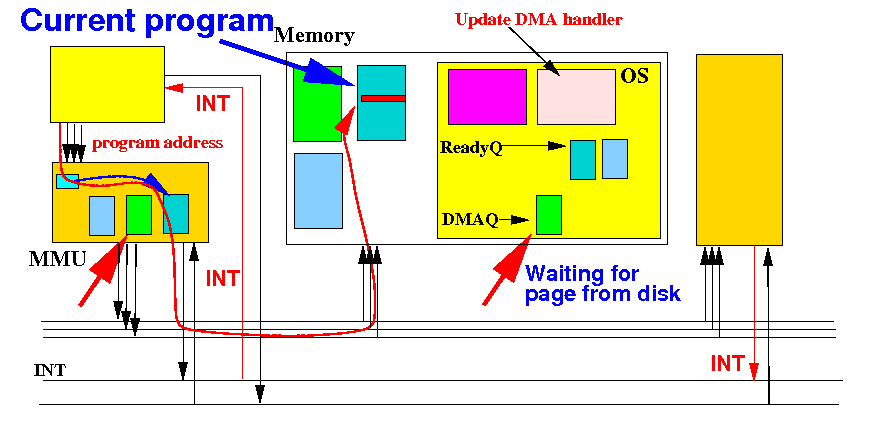
- The CPU will
detect by the
INT signal
and initialize the
vector interrupt handling
protocol
(see:
click here)
to
identify the
interrupt handler
|
The CPU will
execute an
updated
DMA interrupt handler
that we
discussed
previously
Example of the
DMA interrupt handler for a
page fault
- The waiting program will
become the
new
current process
and
The missing page is
now in
memory
(i.e.:
no
page fault)
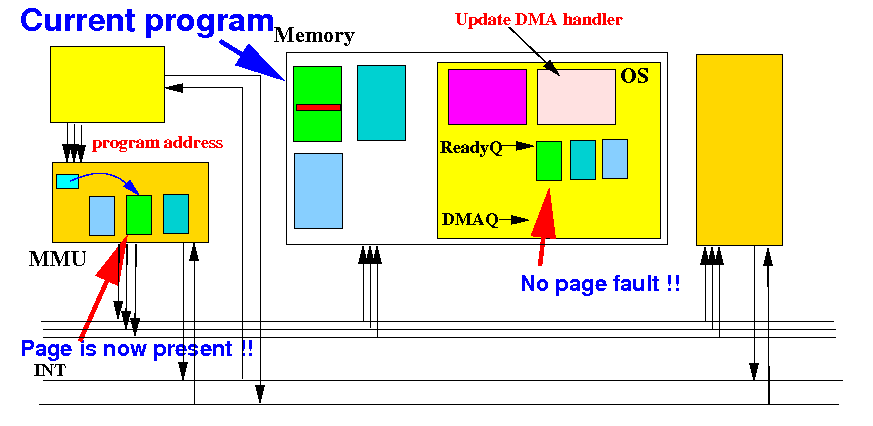
- The CPU will
repeat the
same instruction
(Because the
program counter (PC)
has
not changed)
|
Example of the
DMA interrupt handler for a
page fault
- When the CPU
repeats the
same instruction, the
result will
now be
different:

- Because the
missing page has been
read from disk
(And the page table has been
updated
with the
frame number
to perform the
mapping)
|
Why is paging
successful ?
- Recall:
- Computer programs exhibits
a
execution locality
behavior due to
loops:
-
Programs spend
a lot of time
in one loop before
moving on to
the next
loop
|
- This
execution locality
behavior
was exploited in
caching:
- The cache memory is
much smaller
than the
main memory and
caching
has a
very high hit ratio
|
|
- The
execution locality
behavior
is also the
reason why
paging
is successful:
- Programs spend
a lot of time
in one loop before
moving on to
the next
loop
- If the
memory
contains
all the pages of the
current loop,
the program will
run
as if the
whole program is
in memory !!
|
|
|
❮
❯





